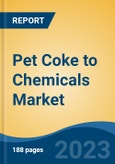Speak directly to the analyst to clarify any post sales queries you may have.
10% Free customizationThis report comes with 10% free customization, enabling you to add data that meets your specific business needs.
The expanding use of pet coke-based chemicals in cement production is another significant driver, as the growth of the construction industry boosts cement demand, thereby increasing the need for pet coke-based chemicals in manufacturing. Additionally, the growing global population and expanding economic activities are escalating energy demands across various sectors, resulting in higher pet coke production, as it is a key feedstock in energy generation. Converting pet coke into chemicals is increasingly seen as a sustainable solution that enhances its efficiency while minimizing environmental impact. As a result, manufacturers in the pet coke to chemicals sector are focusing on expanding their production capacities to meet rising demand.
Key Market Drivers
Growing Demand for Chemicals
The rising demand for chemicals is a primary driver in the global petroleum coke (pet coke) to chemicals market. Pet coke, a carbon-rich solid material produced during oil refining, is increasingly utilized as a feedstock in chemical manufacturing. This trend is fueled by the growing demand for chemical products across various industries such as plastics, fertilizers, synthetic fibers, and specialty chemicals. Pet coke is a cost-effective and readily available feedstock that supports the production of syngas (synthesis gas), hydrogen, ammonia, methanol, and other chemicals.The global chemical industry, valued at approximately $4.7 trillion in 2023, is expanding rapidly due to urbanization, industrialization, and population growth, creating greater demand for feedstocks like pet coke. The shift towards pet coke as a feedstock is driven by its economic advantages over traditional sources like naphtha and natural gas, particularly in regions with limited access to affordable natural gas. Major end-use sectors for pet coke-derived chemicals include plastics and polymers, with methanol and ethylene serving as key building blocks for polyethylene, polypropylene, and other polymers.
Key Market Challenges
Volatility in Feedstock Availability
Petroleum coke plays a critical role as a feedstock in the production of various chemicals, but fluctuations in its availability and quality can significantly impact the supply of pet coke-based chemicals. This volatility is primarily driven by fluctuations in the costs of feedstock and crude oil, which directly affect the price of pet coke. Prices can vary significantly, ranging from under USD 25 per ton to USD 60-72 per metric ton, creating challenges for manufacturers who struggle to predict costs and plan production efficiently. Such price instability can also disrupt the supply chain, adding further complexity to market dynamics.Key Market Trends
Shift Toward Sustainable Practices
As a byproduct of oil refining, petroleum coke is an essential raw material in chemical production. However, concerns over its environmental impact, including potential contributions to greenhouse gas emissions and air pollution, have led the industry to focus on more sustainable practices. Manufacturers are increasingly investing in advanced technologies to convert pet coke into chemicals in a more environmentally responsible way. One such method is carbon capture and storage (CCS), which captures carbon dioxide emissions generated during pet coke production and stores them underground, effectively reducing the overall carbon footprint of the industry.Key Market Players
- BP Plc
- Essar Oil Limited
- Reliance Industries Limited
- Oxbow Carbon LLC
- Repsol S.A.
- ExxonMobil Corporation
- Indian Oil Corporation Limited
- Sinopec Corporation
- Chevron Corporation
- Valero Energy Corporation
Report Scope:
The Global Pet Coke to Chemicals Market has been segmented into the following categories:
By Type:
- Propylene
- Ethylene
- Methanol
- Aromatics
By Application:
- Cement
- Power
- Smelting
- Fertilizers
- Polymer
By Region:
- North America
- United States
- Canada
- Mexico
- Europe
- France
- United Kingdom
- Italy
- Germany
- Spain
- Asia-Pacific
- China
- India
- Japan
- Australia
- South Korea
- South America
- Brazil
- Argentina
- Colombia
- Middle East & Africa
- South Africa
- Saudi Arabia
- UAE
- Egypt
Competitive Landscape
This section includes detailed analysis of key market players in the global pet coke to chemicals market.Available Customizations:
TechSci Research offers customizations of this report according to specific business requirements, including the following options:
- Detailed company profiles for additional market players (up to five).
This product will be delivered within 1-3 business days.
Table of Contents
Companies Mentioned
- BP Plc
- Essar Oil Limited
- Reliance Industries Limited
- Oxbow Carbon LLC
- Repsol S.A
- ExxonMobil Corporation
- Indian Oil Corporation Limited
- Sinopec Corporation
- Chevron Corporation
- Valero Energy Corporation
Table Information
| Report Attribute | Details |
|---|---|
| No. of Pages | 188 |
| Published | February 2025 |
| Forecast Period | 2024 - 2030 |
| Estimated Market Value ( USD | $ 4.6 Billion |
| Forecasted Market Value ( USD | $ 5.86 Billion |
| Compound Annual Growth Rate | 4.0% |
| Regions Covered | Global |
| No. of Companies Mentioned | 10 |









